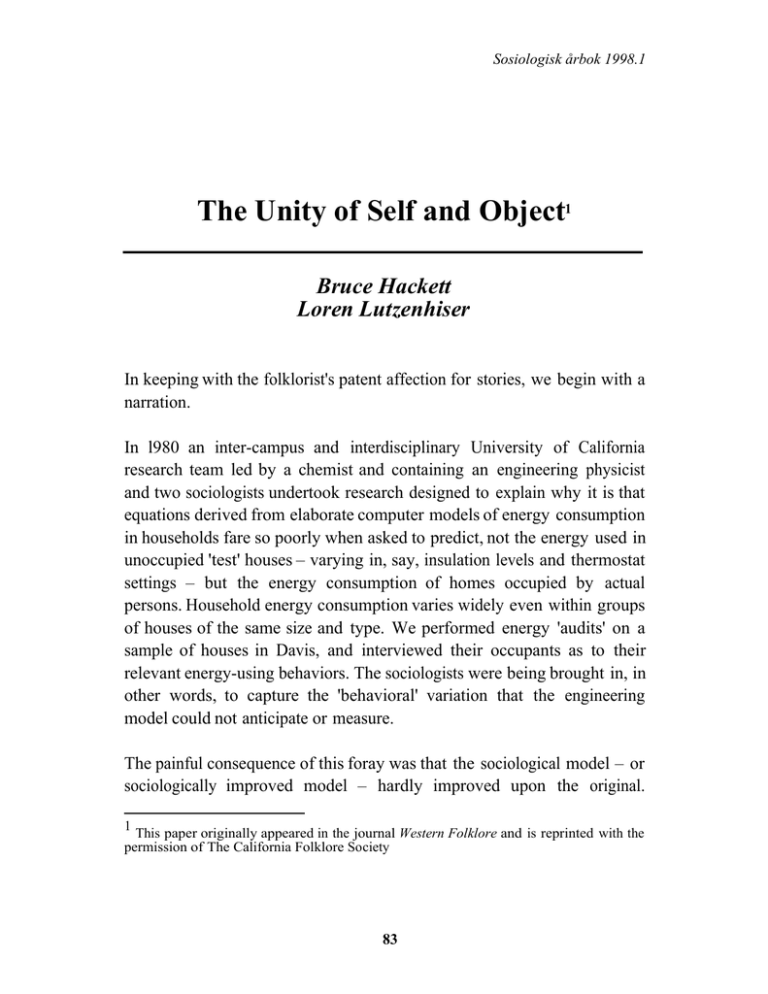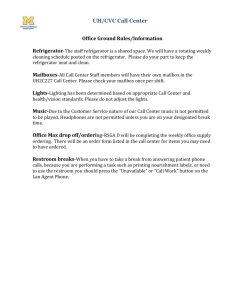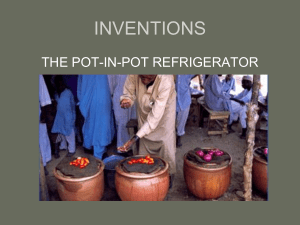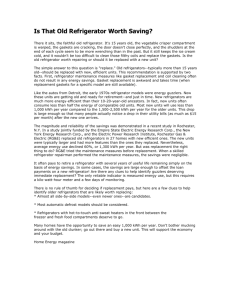The Unity of Self and Object Bruce Hackett Loren Lutzenhiser
advertisement

Sosiologisk årbok 1998.1 The Unity of Self and Object1 Bruce Hackett Loren Lutzenhiser In keeping with the folklorist's patent affection for stories, we begin with a narration. In l980 an inter-campus and interdisciplinary University of California research team led by a chemist and containing an engineering physicist and two sociologists undertook research designed to explain why it is that equations derived from elaborate computer models of energy consumption in households fare so poorly when asked to predict, not the energy used in unoccupied 'test' houses – varying in, say, insulation levels and thermostat settings – but the energy consumption of homes occupied by actual persons. Household energy consumption varies widely even within groups of houses of the same size and type. We performed energy 'audits' on a sample of houses in Davis, and interviewed their occupants as to their relevant energy-using behaviors. The sociologists were being brought in, in other words, to capture the 'behavioral' variation that the engineering model could not anticipate or measure. The painful consequence of this foray was that the sociological model – or sociologically improved model – hardly improved upon the original. 1 This paper originally appeared in the journal Western Folklore and is reprinted with the permission of The California Folklore Society 83 The Unity of Self and Object Without going into detail, let us say simply that the correlation coefficients between the variables derived from the interviews and actual metered energy use were, as these things go, rather low. In an effort to track down the large remaining 'unexplained variation' we re-interviewed a number of persons in our sample, and we did so with a relatively unstructured procedure that asked people to specify actual behaviors rather than tell us – as in the original interview – what they 'usually' or 'normally' do. The wide difference between the 'normal' and the 'actual' in many cases was impressive. Households in which the 'usual' pattern was 'two full loads' of laundry a week might have already had five half-loads this week, and the week was only half over. In time we began to pay special attention to three features of this frequent disjunction between the normal and the actual: first, the possibility that the 'normal account' of one's behavior is designed not to describe it but to manage the interviewing situation; second, that 'deviatons' from the hypothetically normal pattern are unknown even to the deviant – the Self being social enough that persons engage in what Goffman termed "civil inattention" in the face of their own as well as others' stigmata; and third, that even when persons are confronted with this disjunction they are equipped with a reading of it such that their deviations are explained by the existence of 'exceptional events,' unfore-seen contingencies, or special circumstances – those interpretations that insist, in effect, that while the behavior is deviant, the person is not. One might summarize this line of reasoning with the suggestion that, at least in principle, statistically 'normal' behavior may have little to do with the behavior considered morally normal or appropriate in the community – that which is publicly 'accounted for' and publicly displayed in what the dramaturgists refer to as the 'front' of one's life – and that indeed even in that realm one need only be 'periodically' normal if one can muster a full supply of 'special circumstances.' It may follow as well – and this, we think, importantly – that recognition of these methodological issues in 84 Sosiologisk årbok 1998.1 social research comes late because we find it hard to imagine that anything but statistical normality can be applied to behaviors as plainly utilitarian as the use of household appliances. We will reflect again on these issues in a moment, and with particular reference to the guides offered by Jamesian thinking in effecting their resolution. In a subsequent investigation, this time of energy use in an ethnically cosmopolitan group of married student apartments on the Davis campus, we tried to stand even closer to actual doings (as opposed to sayings) by asking the residents of 24 apartments to keep diaries recording their energy use for five days. There were several significant results of this work, but the diaries, and subsequent discussions with their keepers, drew our attention in particular to refrigerators, primarily because of the surprise that virtually all of our informants expressed at the large number of refrigerator openings and closings that their diaries, if not their beliefs about their 'usual' conduct, revealed. This is surely not a major matter so far as energy use is concerned, but we reasoned that close study of persons' relations with this particular kitchen device might help to amend what might be termed the 'theory of tools' that had implicitly guided our initial researches, and have as a consequence a much broader relevance for studies of resource consumption and perhaps for social research in general. Now, the obvious difficulty with this choice of research sites lies in the reserve people might have with regard to the positioning of an ethnographer in their kitchens. Faced with this problem and with the requirement of a somewhat intrusive method, in the next stage of the research we invaded the kitchens of those least able to resist our advances – friends, colleagues, relatives and students. Without advance warning we went so far, in fact, as to ask people if we could obtain a photograph of the box in its present configuration, using a polaroid camera. This would not only obtain a visual record to help us make sense of our subsequent 85 The Unity of Self and Object conversations, but would allow those conversations to proceed without holding open the refrigerator door. The result of these activities was the provision of a variety of data that could not without some considerable distortion be accommodated within what we came to call the 'functional account' or the 'rational account' of the refrigerator – the largely implicit theory of tools (or of, in this case, appliances) noted above. According to that theory, appliance use is a 'means to an end,' and it is sober, wide-awake, pre-planned, intentional rather than habitual or traditional; above all, there is assumed to be a discontinuity between person-using-appliance and the appliance itself, such that person uses appliance but the appliance does not in any significant sense use, identify or define the person. Our emerging hunch was that this model was an instance of cultural 'front' (and in this sense not, we should note, simply a 'bad theory'), in terms of which interview questions are appropriately answered, but not a good guide to the back regions of everyday life. We thought the model seriously challenged by information we sorted roughly into three categories: (l) Materials suggesting that the refrigerator contains what Levi-Strauss refers to as a "bricolage" – an assortment of obviously useful and desirable items for which no use is, at the moment, obviously desirable. The essential idea is that people frequently 'patrol' or 'forage' in the refrigerator (adults are inclined to view this as a 'special problem' with children), not looking for particular items but rather 'taking stock' – even, in fact, allowing the device to indicate their own mood. One of our informants has a small sign near the refrigerator that cautions: 'Do not open the refrigerator to see how hungry you are.' There were some subtle indicators, in fact, that persons often open the refrigerator and then utilize their own activity as an indicator that they must be hungry – otherwise why would they have opened the door? There are, of course, intermediate cases, whole meals that consist of bricolage, of 'leftovers'. 86 Sosiologisk årbok 1998.1 (2) Materials suggesting that several of the uses of the refrigerator are 'accumulated' in the course of 'living with' the box. These are typically discussed as somewhat 'deviant' uses, and we took these stories as indicators of what people do in fact take to be the 'normal' uses of the refrigerator. The stories themselves, in fact, can be read as tales of 'exceptions that prove the rule' and thus constitute part of the verbal work that is done to keep the refrigerator within its proper 'frame' – work that indicates, then, the work that must be done by the person to literally constitute or accomplish what we know as a 'refrigerator.' Under this rubric we have, for example, the case of the herpitologist who keeps a separate refrigerator for the hibernation of snakes, the couple who freeze their garbage, the painter who stores his paintbrushes in the freezer, the woman who washes and then freezes her panty hose for 'longer life,' those who keep valuables such as baby shoes in the freezer, those who store money in plastic containers ("it looks like pesto") or in plastic cabbages (made in Japan) that unscrew, or students who utilize a fake 'coke' can to store 'coke' or other 'controlled substances.' (3) Materials that indicate the use of the refrigerator to socially indicate the character or social standing of its owner, or which suggest that certain types of social structures or social arrangements are, in effect, 'built in' to the box. For example, one female informant informed us that when she took up with a new man she would, early in the relationship, make it a point to inspect his refrigerator to 'see what kind of a man he is.' Another woman complained that she thought her large apartment refrigerator to be constantly demanding the storage of 'large meat items' that were inconsistent with her preferred way of life. And there were several occasions on which persons admitted to, for example, keeping fresh fruits and vegetables in the refrigerator to "indicate our good intentions, but mostly we eat at Wendy's." 87 The Unity of Self and Object Within this general category one of the most revealing types of information was brought forth when we showed our photographs of refrigerators to persons other than their owners; significantly, in our view, the observers almost without exception saw 'types of people' or 'types of families,' not simply refrigerated items, in the pictures. We subsequently tried a crude 'test' of these interpretations by showing people pictures of refrigerators taken in academic departments, not in households, and still the tendency was to see than as revealing a certain peculiar form of 'family' (a nice indicator, no doubt, of the real social work done by refrigerators kept in academic department offices or mail rooms). In the course of this work we were also apprised of the 'familial' character of the refrigerator by being informed repeatedly of the difficulties of 'managing' the refrigerator in student households, a kind of data that might be said to have opened a whole new line of research. Students can become adept at – as one student put it – the 'taxation' of each others' provisions, and there are strategies for doing this: knowing, for example, that the pieces of fudge have been counted, one uses a very sharp knife to but slice slivers from the sides of each piece. Peanut butter and ice cream can be sometimes successfully 'taxed' by carefully drawing one's spoon through these substances in exactly the same configuration as did their (presumptive) owner. There are also small tragedies that inhere in these situations; roommates will not usually begrudge each other a "taste" of milk or peanut butter, but if all members of a student household behave accordingly, the owner's provisions can soon vanish (in a "tragedy of the commons") at the hands of an essentially unwitting collective. One student told us that the rule in his household, a judicious mixture of resignation and principle, is this: "You can tax my butter, and you can tax my milk, but you cannot tax my meat." Now, the connection between these items of information and the wit and wisdom of William James, whom we celebrate on this occasion, is this: that they result from the effort to move the locus of inquiry progressively in the direction James advocated, toward the direct and unmediated 88 Sosiologisk årbok 1998.1 examination of experience. Confronting the resolutely dualistic thoughtways of his day, the surgical divorce between the material or objective 'outer' and the mentalistic or subjective 'inner' realms, with the outer either determining or standing in wait as a resource for the inner, he opted for the idea of their de facto unity in the actual processes of living. His 'radical empiricism' closed the gap between self and object, seeing their relations in experience as the primordial stuff out of which each might be factored for separate viewing but within which no separation occurs; insofar as we can speak of a distinction between self and object within experience at all, the relationship is circular, with self and object 'constituting' each other. Within experience, the dualistic notion of 'personusing-refrigerator' is replaced by 'refrigerator-user;' the tool being used defines the user. For us, the fact that 'third parties' looking at photographs of refrigerators saw selves or social structures (especially families) therein is significantly Jamesian in that it indicates the unity of self and object, and it also suggests that this unity is socially perceived. James also counterposed pre-reflective 'habit' and the 'stream' of experience to the dualistic notion of 'rational' object-use; we found the latter in responses to our questions about 'normal' or 'usual' behaviors, and a great deal of evidence for the former in the diaries that we asked people to keep. More importantly, perhaps, we found a great deal of evidence for the 'openness' of experience insofar as the uses to which the refrigerator is put are emergent, not altogether pre-conceived. The tool, as it were, 'enters into' the determination of its own utilities, suggesting new ideas for its own definition, comes to manage snakes and clothing, and threatens to take on altogether new identities – as vault, closet, display case, morgue. The self must 'manage' this identity in visual, tactile and verbal ways, because this 'tool' is 'self-implicating.' When 'deviations' from the norm are spotted, the 'rationalizations' James saw as the major task of reason itself are offered; these are said to indicate 'special circumstances.' But what they indicate instead is probably a homely version of James's 'pluralistic 89 The Unity of Self and Object universe.' We like to imagine that our researches have started to do for the kitchen what Kinsey did for the bedroom – to indicate the fact of variety against the posturings of 'normality' – and that James would have approved. Finally, we note at least one of the avenues this research has opened to us. Insofar as tools do in fact contribute, in their use, to the determination of their own utility, this means that tools and technologies ought properly to be analyzed historically, as in effect 'social movements.' What they are good for is a consequence, not a determi-nant, of their use, and this means that they are 'cultural' items, aspects of ways of life, 'ingredients' in styles of living as opposed to tools in the sense of 'mere' tools: they have consummatory as well as instrumental meaning. A related idea is that tools do not meet a priori 'needs' – or, better yet, that they contribute to the definition of the problems for which they are solutions. Here we come into contact with one version of another central tenet in James – the importance of 'belief' in the definition, procurement, and construction of 'reality.' Belief generates reality through experience; willingness to try an incipient tool, to believe that it is at tool, is what makes it so. Applied to the area of concern that fostered this inquiry, for example, this implies the legitimacy of experimenting with 'alternative' energy technologies in the realization that people will, and do, adapt their needs to the devices they have for meeting them. But all of this requires a great deal of respect for experience. A sociology fully grounded in experience, implicitly a celebration of James, has yet to emerge, although the fetal stages are there, in the ethnographic approach. Whatever the abuses and vulgarities to which the term 'experience' may be prone – and Roger Abrahams has certainly helped us to remember them – this protean concept seems the best weapon we have against the traditions of positivism and functionalism in the social sciences. Infatuation with either an individualized or a social but essentially generic conception that does not recognize variations of intensity in experience can direct 90 Sosiologisk årbok 1998.1 attention away from what Abrahams calls the Big Times and from a culture's central ritual core. But the concept does try to direct attention to social life as lived, as opposed to its explanations, causes or functions. It can, in fact, suggest the sense in which the latter are themselves the products, not the antecedents, of living. It can direct attention, then – in the manner advocated by the philosophical Pragmatists – to outcomes and consequences, among these being the 'reasons' commonly treated as antecedent motives. As a corollary, we are more likely to find in the background of or as antecedent to current practical, need-satisfying, instrumental activity a sense of play or experimentation. We tried to emphasize the sense in which 'refrigeration,' as an active noun, can be seen as open-ended in its meaning and even playful, its 'need' largely emergent, but the analytic point that tools create their own need can be broadly generalized: the revised sociological theory of 'deviance' makes it clear, at least to us, that without the rhetorical workings of church-men, psychiatrists, teachers and policemen we would not include the sinner, the mentally ill, the ignorant or the criminal among the identities available to people in our social world – that the solutions, in short, are always the best guide to the problems. It would be tempting to suggest that this theoretical development makes it possible to see even the diagnostic categories of these professions as 'folklore' in the vernacular sense in which folklore stands for the not-quite-justified celebration of accumulated practice. To argue that tools can be said to act, in their use, to confer rather selfserving identities on their users (to gradually become, in one formulation, "institutions") is to adopt a posture that seems congruent with the longterm shift from a focus on the 'text' to a concern with context, interpretation, and performance, with the proviso that these distinctions are themselves problematic. The unit of analysis in the refrigerator study is the entire circle that includes the box, the user and the audience to that use, each of these being at times interchangeable; we say, again, that the refrigerator 'embodies' its user-audience, just as the user-audience must 91 The Unity of Self and Object 'perform' the refrigerator, keeping it within its proper 'frame.' And the 'circle' described here is social, insofar as self and object are socially defined and there is social complicity in the maintenance of definitions: access to refrigerators is a socially and carefully regulated matter. Finally – and in keeping with the Pragmatic project – we think it important to explore the sense in which esthetic considerations guide the 'composition' of the tool and its circle. We have toyed at length with the seemingly esthetic issues that arise continuously in refrigerator-stories if one hears and sees them in that fashion – issues concerning proper storage and warehousing strategy, cleaning routines, selection of contents and containers. The refrigerator can be likened, sometimes is explicitly likened, to a piece of kinetic sculpture, a household art-object-in-process, constantly modified (or not modified) so that it looks, feels, is 'right.' It is true, of course that we do not gather audiences to gaze upon the fridge, or gather refrigerators together in galleries. This device is not the centerpiece of large and carefully crafted ritual. But then it is not really clear why refrigerators are not the stuff of galleries; in fact, it isn't really clear that they aren't. Much of social science, after all, is an effort to find sacred meaning in profane arrangements, or to reclaim ritual before it's lost to the language of utility, and included here might be license to 'see' the kitchen as a gallery of sorts. Debate as to the legitimacy of such a framing might be fruitful, but in any case it would seem to be legitimate debate within folkloric studies, where tools can be examined as items of culture and there seems to exist, almost as a defining characteristic of the field, sympathy for an experiential and generic conception of art. 92 Sosiologisk årbok 1998.1 93








